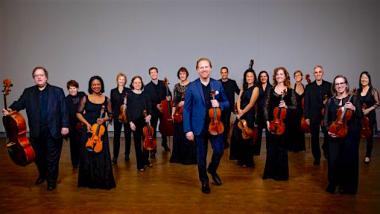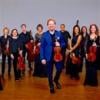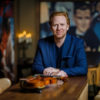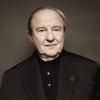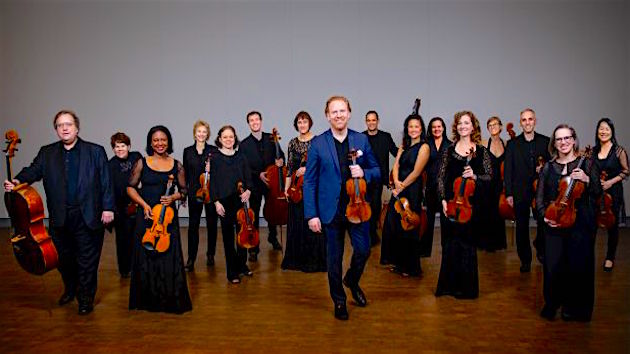
“Forbidden Music” was the theme but not the affect of a delightful offering from the New Century Chamber Orchestra on Sunday. The afternoon visit to the Osher Marin Jewish Community Center in San Rafael was the last on the Orchestra’s four-day tour, which had previously taken them to Berkeley, Palo Alto, and San Francisco.
Two of the pieces were among Felix Mendelssohn’s String Symphonies, now almost two centuries old, written when the composer, a German of Jewish ancestry, was between 12 and 14 years of age. Their thematic inclusion in this program referred to the 20th-century banning of Mendelssohn’s music by the Nazis, even though the composer was not raised Jewish and was baptized as a Calvinist.
The orchestra, standing on stage (except for the cellos), experienced a slightly muddled start to the String Symphony No. l3 (whose designation as “Sinfoniesatz” reflects that it is limited to an overture followed by a fugue, rather than a full symphony), but sharpened up their intonation as their pace accelerated. Even more impressive than the prodigious Mendelssohn’s mastery of large-ensemble form was his success in channeling his revered antecedent Bach, whose music he’s credited with raising to widespread acclaim.
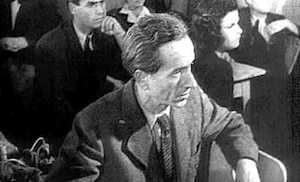
Two other “forbidden” pieces on the program were by composers who perished in Nazi concentration camps, their already-established careers cut short by racist tyranny. Introducing the first of these, Hans Krása’s Tanec, New Century’s concertmaster and Music Director Daniel Hope pointed out that the Nazis had at first forbidden musical expression within the camps until they realized that the activity might bolster morale and render the prisoners more tenable. Krása, noted Hope, had admired both Bach and Mendelssohn. The latter’s influence was audible in the light tone poem touch of this piece, which bears no apparent emotional evidence that it was written and performed within the Theresienstadt concentration camp, in the composer’s native Czechoslovakia. New Century’s string sections deftly traded off the juxtaposition of pizzicati against bowed delivery of themes, the dance-oriented music (telegraphed by the Czech title) furthered by tricky, Bernsteinian syncopation. Krása favored the Phrygian dominant mode shared by much of the Jewish and Romani folk music that would have abounded in his country before the invasion of the Germans.
For Dmitri Shostakovich, who composed the chamber symphony that came next, forbiddance was imposed — sporadically and unpredictably — by the dogmatic Soviet hierarchy. Hope described this symphony as based on eight of the composer’s previous string quartets, as well as on evocations of different aspects of his life up to the time of the creation of this work in 1960. There’s evidence also of Shostakovich’s “great sympathy for the Jews and Jewish music,” and of a clever musical translation of the composer’s own initials, first heard in a moody, elegiac theme that rather evokes the first of the Sea Interludes from Benjamin Britten’s Peter Grimes. Here again, the sections of the ensemble massed masterfully, moving on to a spectral waltz and disturbed eddies. Ominous fortissimo tutti triplets were followed by an artful solo by Hope, and a sweet Largo movement toward a possibly hopeful conclusion.
After intermission, the multigenerational audience returned for a full-length Mendelssohn string symphony, the No. 10. The Bach homage was again apparent, with a fetching blend of serioso and playfulness, perhaps reflective of the composer’s early adolescent perspective on life. Interestingly, the thematic development here seemed somehow more mature than in the No. 13, and the strong supportive role of the three cellos and single double-bass, all ably played here, evinced precocious good taste.
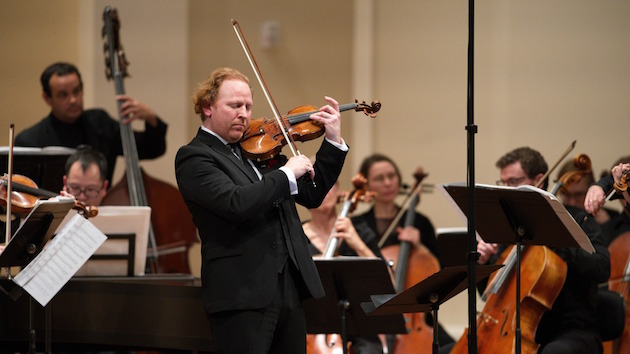
According to Hope, Antonín Dvořák, shortly before his death, gave his blessing to child musician and fellow Czech Erwin Schulhoff, who would go on to concertize and compose until he died of tuberculosis in a Bavarian concentration camp. For Schulhoff’s Double Concerto, Hope, who “stole the [composed] flute part and turned it into a violin part,” was partnered by Venezuelan-American pianist Vanessa Perez, and the New Century strings were bolstered by a pair of French horns. In his biographical notes, Hope related that Schulhoff had been fond of both jazz and Beethoven, whose Heroic Variations he quoted in this piece, and that the composer had somehow managed to set the Communist Manifesto to music. Also apparent in the opening Allegro moderato movement was the melodic influence of Schulhoff's friend Alban Berg. Perez and Hope shared crisp, bright lines when Hope wasn’t stepping aside to conduct the ensemble, sometimes by hand, sometimes with baton, through tricky but engaging switchbacks of time signature. The New Century’s artful pacing was best tested and satisfyingly displayed in this section.
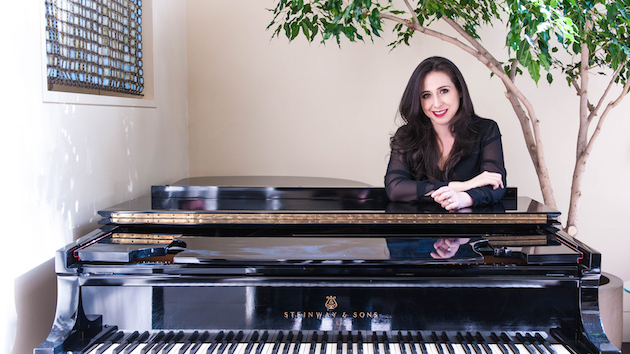
The Concerto’s Andante movement gave Hope a place to invoke a marvelous variety of voices from his violin, giving a listener cause to ponder whether this could have worked on the flute to which this melody was originally assigned. The horns provided a warmly burnished response. The Allegretto movement hinted at the composer’s affection for jazz, danced here in a Gershwin-tinged blue mode. The New Century showed it could swing.
As an encore, the Osher Marin was celebrated in its Jewish connection with a performance of Maurice Ravel’s Kaddish, reverently intoned by Hope’s violin, alluringly underscored on Perez’s piano.

